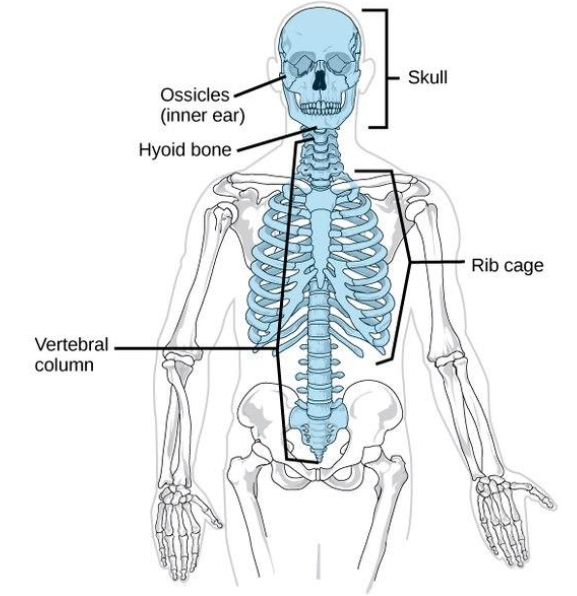
In man the axial skeleton is made up of
A. 80 bones
B. 100 bones
C. 103 bones
D. 106 bones
Answer
558k+ views
Hint: Axial skeleton comprises the bones that lies along the central axis of human body.
It is constituted by skull bones, ribs, vertebral column, etc.
Complete answer:
Skull is made up of two sets of bones: Cranial & Facial, constituting a total of 22 bones.
Out of 22 skull bones, 8 are cranial bones while 14 are facial bones.
> CRANIAL BONES (8): Constitutes Frontal bone (1), Parietal bones(2), temporal bones(2), Occipital bone(1), Ethmoid bone(1) and Sphenoid bone(1).
> FACIAL BONES (14): Facial bones are constituted by Maxilla (2), Palatine (2), Zygomatic (2) Nasal (2), Lacrymal (2), Inferior Turbinals (2), Mandible (1) and Vomer (1).
> There is one Sternum lateral to which ribs are arranged.
> 12 pairs of ribs are present in the human body. Out of these 12 pairs, 7 pairs are true ribs i.e. they are attached to the sternum on the ventral side as well as attached to vertebrae on the dorsal side. The 8th, 9th and 10th pair of ribs are called false ribs as they are merged into one another and then attached to the sternum as a single rib. The 11th & 12th pair of ribs is called floating rib as it is only connected to vertebrae on its dorsal side, there is no attaching surface on ventral side for these ribs.
> Vertebral column: Formed by 26 linearly attached units called vertebrae, lying dorsally to the body. They are classified as follows:
- Cervical: 7
- Thoracic: 12
- Lumbar: 5
- Sacral: 5 (Fused into 1)
- Lumbar: 4 (Fused into 1)
> Associated skull bones: 7
Hyoid bone: 1 (Only bone that do not attach to any other bone)
Ear ossicles: 2*3 (Malleus, Incus, Stapes)

Thus, the correct option is (A) 80 bones.
Note:
Bones in the body that are formed by ossification of tendons are called sesamoid bones.
Longest and strongest bone of the human body is femur.
Smallest bone of the human body is stapes.
Rabbit - axial skeleton 132 bones, appendicular skeleton 128 bones.
It is constituted by skull bones, ribs, vertebral column, etc.
Complete answer:
Skull is made up of two sets of bones: Cranial & Facial, constituting a total of 22 bones.
Out of 22 skull bones, 8 are cranial bones while 14 are facial bones.
> CRANIAL BONES (8): Constitutes Frontal bone (1), Parietal bones(2), temporal bones(2), Occipital bone(1), Ethmoid bone(1) and Sphenoid bone(1).
> FACIAL BONES (14): Facial bones are constituted by Maxilla (2), Palatine (2), Zygomatic (2) Nasal (2), Lacrymal (2), Inferior Turbinals (2), Mandible (1) and Vomer (1).
> There is one Sternum lateral to which ribs are arranged.
> 12 pairs of ribs are present in the human body. Out of these 12 pairs, 7 pairs are true ribs i.e. they are attached to the sternum on the ventral side as well as attached to vertebrae on the dorsal side. The 8th, 9th and 10th pair of ribs are called false ribs as they are merged into one another and then attached to the sternum as a single rib. The 11th & 12th pair of ribs is called floating rib as it is only connected to vertebrae on its dorsal side, there is no attaching surface on ventral side for these ribs.
> Vertebral column: Formed by 26 linearly attached units called vertebrae, lying dorsally to the body. They are classified as follows:
- Cervical: 7
- Thoracic: 12
- Lumbar: 5
- Sacral: 5 (Fused into 1)
- Lumbar: 4 (Fused into 1)
> Associated skull bones: 7
Hyoid bone: 1 (Only bone that do not attach to any other bone)
Ear ossicles: 2*3 (Malleus, Incus, Stapes)

Thus, the correct option is (A) 80 bones.
Note:
Bones in the body that are formed by ossification of tendons are called sesamoid bones.
Longest and strongest bone of the human body is femur.
Smallest bone of the human body is stapes.
Rabbit - axial skeleton 132 bones, appendicular skeleton 128 bones.
Recently Updated Pages
A man running at a speed 5 ms is viewed in the side class 12 physics CBSE

State and explain Hardy Weinbergs Principle class 12 biology CBSE

Which of the following statements is wrong a Amnion class 12 biology CBSE

Two Planoconcave lenses 1 and 2 of glass of refractive class 12 physics CBSE

The compound 2 methyl 2 butene on reaction with NaIO4 class 12 chemistry CBSE

Bacterial cell wall is made up of A Cellulose B Hemicellulose class 12 biology CBSE

Trending doubts
What are the major means of transport Explain each class 12 social science CBSE

Which are the Top 10 Largest Countries of the World?

Draw a labelled sketch of the human eye class 12 physics CBSE

Explain sex determination in humans with line diag class 12 biology CBSE

Give 10 examples of unisexual and bisexual flowers

State the principle of an ac generator and explain class 12 physics CBSE




